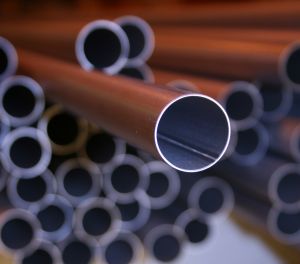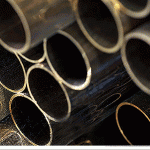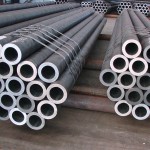Carbon Steel Tube

Carbon steel tube is an affordable option for a variety of pipe and tube applications. This tube can be used for machinery parts as well as a number of other applications. Advantages of using carbon steel tubing are easy machinability, large variety of OD and wall thicknesses, and lower costs than alloy and stainless tubing.
The first methods for producing steel pipe were introduced in the early 1800s, and they have steadily evolved into the modern processes we use today. Large diameter steel pressure pipes for water and wastewater applications are typically made with carbon steel and installed as buried assets. Steel pipe can be made using three main methods:
- Seamless (extrusion mold) – Hot steel is pushed through a die to create the pipe shape. Diameters of up to 20” (500mm) can be made this way. Expensive but the most reliable.
- Welded – A sheet of steel is wrapped around a form then welded at the seam. Less expensive but not as reliable as seamless for high-pressure situations.
- Casting Mold – Hot liquid steel is poured into a mold. Not very common and as reliable as seamless.
The primary benefit of steel pipe is its strength. These pipes don’t crack under most impacts and can operate under high pressure. Under abnormal loads, steel will bend, rather than break.
Advantages
- High tensile strength
- High compressive strength
- Range of corrosion protection systems
- Wide range of diameters and wall thickness
- Welded joints give continuity
Disadvantages
- Prone to external corrosion
- Electrolysis prone
- Jointing requires skilled welders
- Internal/external corrosion protection systems add to price
- Coatings and linings can get damaged during installation and by third parties
Main Forms Failure in Steel Pipes
| Form of Failure | Causes of Failure | Indicators of Failure |
| Break failure | Pitting corrosion weakening wall | Damage to coating/linings, wall loss, pitting, and leaks |
| Longitudinal cracking | Thinning from general corrosion, and areas of pitting corrosion | Graphitization, groups of pitting, and wall loss |
| Pipe bursts | Third party damage | Construction activity |
Three constraints affect the cross-sectional dimensions of welded tube:
- Outside diameter (OD)
- Gauge (wall thickness)
- Inside diameter (ID)
An as-welded tube manufacturer can control the OD and gauge of the tube. Since the tube is manufactured from the outside by a series of rolls that ultimately produces the final OD size of the tube, the ID varies by the combination of the final OD and gauge. Tight tolerance tubing reduces ID variation compared to that of conventional tubing produced to American Society for Testing & Materials (ASTM) standard 513. For fabricators, this reduction helps to provide improved quality, reduced scrap, and the possible elimination of processing steps.










